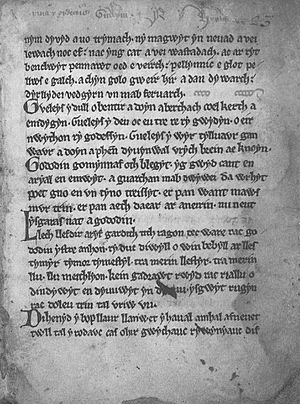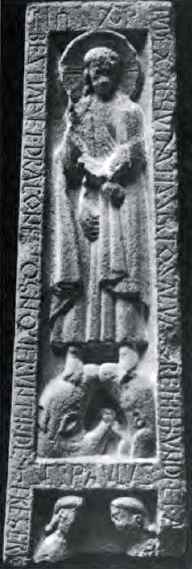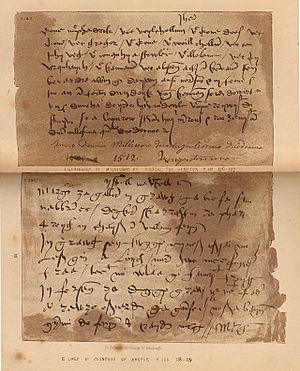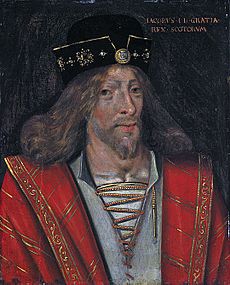Scottish literature in the Middle Ages facts for kids

Scottish literature in the Middle Ages covers books and poems written in Scotland, or by Scottish writers, from the 400s to the late 1400s. This was a long time, from when the Romans left Britain until the Renaissance began. During this period, people in Scotland wrote in many languages. These included Brythonic (like early Welsh), Scottish Gaelic, Scots, French, and Latin.
Many early Welsh poems were actually written in or near what is now Scotland. One famous example is The Gododdin, an epic poem. It is thought to be the oldest surviving poem from Scotland. Not many Gaelic poems from this early time still exist, and most are found in Irish books. Some religious writings from Scotland in Gaelic do remain.
In Old English, we have parts of the Dream of the Rood. Lines from this poem are carved on the Ruthwell Cross. This makes it the only piece of Old English writing from early Medieval Scotland that we still have. The most important work from this time, Vita Columbae by Adomnán, was written in Latin.
As the kingdom of Alba grew into the Kingdom of Scotland, writers often created texts in Gaelic and Latin. They shared a common writing style with Ireland. Later, in the late Middle Ages, Middle Scots became the main language. The first big book in Scots was John Barbour's Brus (1375). Poets called makars wrote much of the literature. Many of their works are in the Bannatyne Manuscript. Scots prose also started to appear, with John Ireland's The Meroure of Wyssdome (1490) being the first full surviving work.
Contents
Early Medieval Literature (400s-1000s)

After the Roman Empire ended around 400 AD, four main groups lived in northern Britain. In the east were the Picts, who spoke a Brythonic language. In the west were the Gaelic-speaking people of Dál Riata. They came from Ireland and brought the name "Scots" with them. In the south were the British people, whose language was also Brythonic. The most powerful of their kingdoms was Kingdom of Strathclyde. Finally, there were the English, or "Angles." They were Germanic invaders who settled in the southeast.
As Christianity spread from the 500s, Latin became an important language for writing. No Pictish writings have survived. However, we still have literature from Scotland in Brythonic, Gaelic, Old English, and Latin.
Brythonic Writings
Many early Welsh poems were actually written in or near Scotland. This was because the Brythonic language was spoken there too. These poems were only written down in Wales much later. The Gododdin is the oldest surviving poem from Scotland. It is believed to be by Aneirin, a poet from the 500s. It tells the sad story of men from Gododdin who died in battle around 600 AD. Another poem, Battle of Gwen Ystrad, is linked to Taliesin, a poet from the kingdom of Rheged.
Gaelic Writings
Very few Gaelic poems from the early Middle Ages still exist. Most of these are found in old Irish books. Some religious works from Scotland include the Elegy for St Columba (around 597). Another is "In Praise of St Columba" (around 677). Some poems praising Pictish kings are found in Irish records. These poems were likely written in Scotland.
Old English Writings
In Old English, we have the Dream of the Rood. Lines from this poem are carved on the Ruthwell Cross. This is the only piece of Old English writing from early Medieval Scotland that remains. Some people also think the poem The Seafarer was written near the Bass Rock in East Lothian.
Latin Writings
Early Latin works include a "Prayer for Protection" from the mid-500s. There is also Altus Prosator ("The High Creator"), thought to be by St Columba. The most important work from this time is Vita Columbae. It was written in Latin by Adomnán, an abbot from Iona (627/8–704). Another important Latin work is the Life of St. Ninian, written in Whithorn.
High Medieval Literature (1000s-1200s)
From the late 700s, Viking attacks may have led to the Gaelic and Pictish kingdoms joining together. This created the Kingdom of Alba, which later became the Kingdom of Scotland. This kingdom was mostly Gaelic-speaking. In Ireland, there were `filidh`, who were poets, musicians, and historians. They often worked for kings and passed on their knowledge. Scotland likely had similar people. Over time, Gaelic replaced Pictish and Cumbric languages in many areas.
From the 1000s, French, Flemish, and English became the main languages in Scottish towns. These towns were mostly in the south and east. When David I became king (1124–53), French culture became very important. French likely replaced Gaelic as the main language at the royal court. After this, a different group of poets, called `bards`, took over. They continued to work in the Highlands and Islands until the 1700s. They often trained in special bardic schools. Much of their work was not written down. What we have was recorded from the 1500s onwards.
It is possible that more Gaelic literature was written in Medieval Scotland than we know. Many works may have been lost because the Gaelic writing tradition in eastern Scotland ended before the 1300s. For example, some scholars think the Lebor Bretnach (the "Irish Nennius") was written in Scotland. But this book only exists in copies found in Ireland. Other surviving works include poems by Gille Brighde Albanach. His poem Heading for Damietta (around 1218) describes his experiences during the Fifth Crusade.
The 1100s were a great time for writing about saints in Scotland. Many new Latin stories about early Celtic and Scottish saints appeared. These stories often helped create legends for religious places like St. Andrews and Glasgow. Many old saints' lives are kept in the Aberdeen Breviary (1509–10).

In the 1200s, French became a popular language for literature. The Roman de Fergus is the oldest non-Celtic story from Scotland written in French. Many other stories about King Arthur, written in French, might also have been written in Scotland. Some Norse literature comes from areas where Vikings settled, like the Northern and Western Isles. However, the famous Orkneyinga Saga was written in Iceland. Latin was also used for writing. Examples include a poem celebrating Glasgow's victory over Somairle mac Gilla Brigte.
Late Medieval Literature (1300s-1500s)
In the late Middle Ages, Middle Scots became the main language in Scotland. It came mostly from Old English, with words from Gaelic and French. From the late 1300s, it became a distinct language from English spoken in northern England. As the ruling class stopped using French, they started using Middle Scots. By the 1400s, it was the language of government. This meant Gaelic, once common north of the Tay River, began to decline. Writers in the Lowlands often saw Gaelic as a less important language.
The most important collection of Medieval Scottish Gaelic poetry is The Book of the Dean of Lismore. It was put together by brothers James and Donald MacGregor in the early 1500s. It contains Gaelic poems from Scotland and Ireland. It also has some poems and stories in Scots and Latin. The topics include love poems, heroic songs, and philosophical ideas. It is special because it includes poems by at least four women. One of them, Aithbhreac Nighean Coirceadail (around 1460), wrote a sad poem for her husband.

The first major book in Scots that still exists is John Barbour's Brus (1375). It was written for King Robert II. This epic poem tells the story of Robert the Bruce and the Scottish fight for independence. It was very popular. Barbour is seen as the father of Scots poetry, much like Chaucer in England.
Important historical works in Latin include the Chronica Gentis Scotorum by John of Fordun (before 1360–c. 1384). This book was used by later historians, like Walter Bower (c. 1385–1449) for his Scotichronicon. In the early 1400s, Scots historical works included Andrew of Wyntoun's Orygynale Cronykil of Scotland. There was also Blind Harry's The Wallace. This book mixed historical stories with verse. These works were likely influenced by Scots versions of popular French adventure stories. These included The Buik of Alexander and Launcelot o the Laik.
Many poets called makars wrote Middle Scots literature. They often had links to the royal court, including King James I himself, who wrote the long poem The Kingis Quair. Many makars went to university and were also connected to the Church. However, William Dunbar's Lament for the Makaris (around 1505) shows that there were many other writers outside the court and church whose works are now lost. Writers like Dunbar, Robert Henryson, Walter Kennedy, and Gavin Douglas are seen as creating a golden age of Scottish poetry. Major works include Richard Holland's funny poem Buke of the Howlat (around 1448). Much of their work is found in one collection, the Bannatyne Manuscript. George Bannatyne (1545–1608) put it together around 1560. It contains the work of many Scots poets who would otherwise be unknown.
In the late 1400s, Scots prose (writing that is not poetry) also began to grow. The first full surviving work is John Ireland's The Meroure of Wyssdome (1490). There were also Scots translations of French books about knights and chivalry from the 1450s. These included The Book of the Law of Armys and The Order of Knychthode. Another was Secreta Secretorum, an Arabic work thought to be Aristotle's advice to Alexander the Great.
A very important work during the reign of King James IV was Gavin Douglas's version of Virgil's Aeneid. This translation, called the Eneados, was finished in 1513. It was the first full translation of a major classical text into an English-like language. However, it was overshadowed by the terrible defeat at the Battle of Flodden in the same year.


